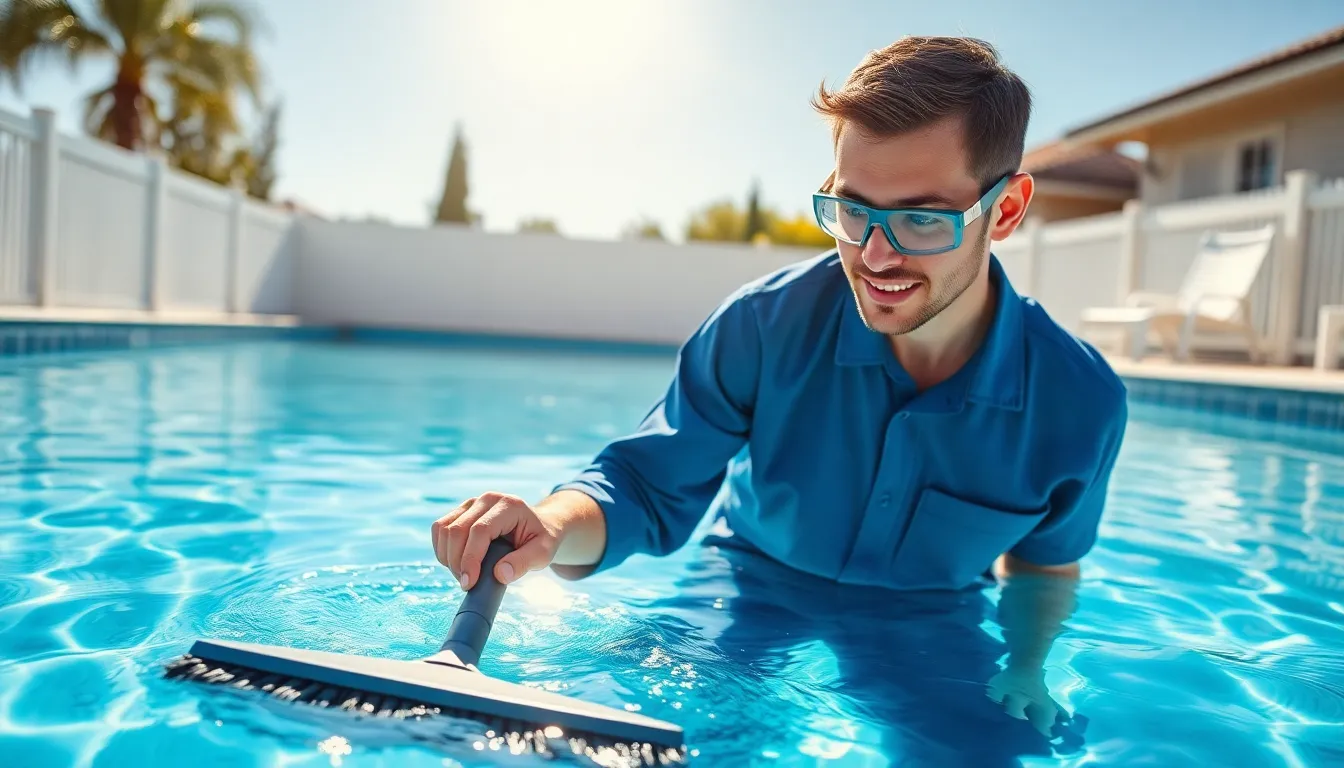Table of Contents
ToggleOwning a swimming pool is like having a personal slice of paradise right in your backyard. But let’s face it—paradise comes with a price tag. When it comes to swimming pool maintenance costs, they can feel like a game of Marco Polo, where you’re always chasing after those elusive numbers.
Factors Influencing Swimming Pool Maintenance Cost
Several factors influence swimming pool maintenance costs, affecting the overall investment for pool owners. Understanding these elements helps in budgeting effectively.
Type of Pool
Different pool types carry varying maintenance costs. In-ground pools generally incur higher expenses due to equipment and installation requirements. Above-ground pools, however, typically have lower maintenance needs, translating to reduced costs. Additionally, specific materials impact overall upkeep. For instance, vinyl-lined pools may need more frequent repairs compared to fiberglass alternatives. Each type carries its own set of chemicals and cleaning products, which also affect long-term costs.
Size of Pool
Pool size plays a pivotal role in determining maintenance expenses. Larger pools require more chemicals, water, and time for cleaning. The cost of heating a larger body of water influences utility bills significantly too. Conversely, smaller pools involve fewer materials and less time for upkeep. Efforts to maintain a compact swimming space, therefore, lead to lower overall expenditures. Ultimately, size isn’t just a comfort factor; it’s a major cost consideration.
Location
Location significantly impacts swimming pool maintenance costs. Pools situated in areas with high temperatures require more water to counteract evaporation, leading to increased utility costs. Regions with heavy rainfall might lessen the need for frequent water replenishment, though they increase debris management. Additionally, local regulations can influence maintenance processes and total expenses. In areas with strict ecological guidelines, compliance might raise costs, compelling owners to invest in specialized services or equipment. Recognizing these nuances is crucial for effective cost planning.
Common Maintenance Tasks and Their Costs

Maintaining a swimming pool involves several essential tasks. Each task contributes to overall pool health and varies significantly in cost.
Regular Cleaning
Regular cleaning ensures pool water remains clear and inviting. Pool owners typically face a monthly cleaning cost of $100 to $300, depending on the pool size and type. Skimming debris from the surface, vacuuming the floor, and cleaning the walls are essential activities. Hiring a professional may increase expenses but ensures thorough cleaning. He or she can remove grime, algae, and dirt effectively. Additionally, maintaining a clean filter contributes to longer-lasting pool equipment and clearer water.
Water Treatment
Water treatment is critical for safe swimming conditions. Chemical costs for maintaining imbalance typically range from $20 to $100 per month. Testing the water for pH, chlorine, and alkalinity requires regular monitoring. Adjusting these levels prevents harmful bacteria growth and skin irritation. Pool owners often employ services to manage water quality, which can add $75 to $150 for each visit. Maintaining optimal water conditions protects both swimmers and the integrity of the pool.
Equipment Maintenance
Equipment maintenance ensures the pool system operates efficiently. Pool owners spend about $100 to $300 annually on equipment upkeep. Regular checks on pumps, filters, and heaters prevent costly malfunctions. Simple tasks include cleaning the filter and ensuring proper operation of the pump. Any repairs needed may incur additional expenses, sometimes exceeding $500 depending on the severity. Timely maintenance promotes longevity, saves money, and keeps the pool sparkling and enjoyable.
Seasonal Considerations for Costs
Seasonal factors significantly affect swimming pool maintenance costs. Each season brings unique challenges and expenses for pool owners.
Winterizing Your Pool
Winterizing a pool is essential for protecting it from freezing temperatures. Owners typically spend between $100 and $300 on winterizing supplies and services. Key expenses include covers, chemicals, and draining equipment. Pool covers, which prevent debris accumulation, range from $50 to $200. Additionally, specialized winter chemicals cost about $20 to $75. Proper winterization helps avoid costly repairs and preserves the pool’s structure over the colder months.
Opening Your Pool in Spring
Opening a pool in spring involves various costs that ensure readiness for use. Expenses range from $200 to $500, depending on the pool’s size and previous maintenance. Preparing the pool often requires removing the cover, cleaning debris, and balancing water chemistry. Cleaning supplies and fresh chemicals typically account for $50 to $150. Engaging a professional service can add $300 to the total, but they ensure thorough preparation for safe swimming. Proper spring opening maintains the pool’s condition and enhances enjoyment during warmer months.
Budgeting for Swimming Pool Maintenance
Budgeting for swimming pool maintenance involves understanding various expenses associated with ownership. Monthly cleaning costs generally range from $100 to $300, influenced by the pool’s size and type. Allocating funds for water treatment is equally essential, with chemical costs typically between $20 to $100 monthly. Additional service fees for water quality management can arise, making this an important aspect of regular maintenance.
Annual equipment maintenance averages between $100 to $300, focusing on the upkeep of pumps, filters, and heaters. Repair costs could exceed $500 if equipment malfunctions occur. For long-term budgeting, it’s wise to account for unexpected expenses.
Seasonal considerations play a crucial role in the overall maintenance budget. Winterizing a pool typically incurs costs from $100 to $300, covering supplies, services, and specialized winter chemicals. This investment protects the pool from freezing temperatures and helps prevent costly repairs.
Costs for opening a pool in spring can range from $200 to $500. This expense encompasses removing the cover, cleaning debris, and balancing water chemistry. Hiring professional services ensures thorough preparation for a safe swimming experience after winter.
Considering location is vital when budgeting for pool maintenance. Climate conditions and local regulations significantly influence maintenance costs. Pool owners should also think about the type of pool they own. In-ground pools generally require higher maintenance compared to above-ground pools, impacting overall budgeting strategies.
Planning ahead for these various costs can greatly enhance the enjoyment of the pool while safeguarding the investment.
Understanding swimming pool maintenance costs is key for any pool owner. By recognizing the various factors that influence expenses and budgeting accordingly, they can ensure a more enjoyable experience. Regular upkeep not only maintains the pool’s aesthetic appeal but also safeguards its longevity.
Seasonal tasks like winterizing and opening the pool require careful planning to avoid unexpected costs. By being proactive about maintenance, pool owners can protect their investment and enjoy their personal paradise without the stress of financial surprises. Ultimately, a well-maintained pool offers endless enjoyment and relaxation for family and friends.




